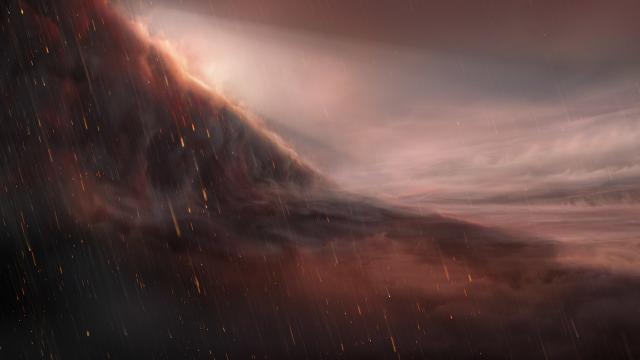Don’t forget to bring your sturdiest umbrella when you travel to the extra-hot planet WASP-76b, where it may literally rain molten iron.
Hot Jupiters represent some of the galaxy’s most hellish worlds, giving scientists clues into the diverse planetary climates and atmospheric chemistry that can come about in extreme conditions. A new analysis of the exoplanet WASP-76b demonstrates vastly different day and nighttime climates—like super-hot, cloud-free days that lead to nighttime iron rain.
The researchers from observatories around the world took data on the nearly Jupiter-sized exoplanet on September 2 and October 30, 2018, using the Echelle Spectrograph for Rocky Exoplanets and Stable Spectroscopic Observations (ESPRESSO) instrument at the European Southern Observatory’s Very Large Telescope. This instrument takes spectra, meaning that the researchers can use it to uncover the star’s elemental composition in relatively high resolution. This planet orbits incredibly close to its 6,329-degree-Kelvin (6,056 Celsius) parent star, completing a year in just 1.81 days.
The team calculated a daytime temperature of 2,693 kelvin (2,420 C). Then, they tried to create a model that would explain the data they observed. Most intriguingly, they saw a strange signal from iron atoms, which appeared to be absorbing energy during the day but not at the transition between day and night, according to the paper published in Nature.
What’s going on? The very hot temperatures tear apart molecules on the surface of these planets, which nearly have similar temperatures to cool stars. These dissociated atoms are slow to move around due to the electromagnetic forces between them, meaning that heat moves around more slowly, creating a large difference between daytime and nighttime temperatures. On the nighttime side, the planet would be much cooler, perhaps two-thirds the dayside temperature, and iron there could condense into clouds and perhaps even rain.
This work is a model that attempts to explain data, and models rely on human assumptions and thus aren’t always correct. The study’s authors did not respond to Gizmodo’s request for comment.
But such chaos wouldn’t be surprising on a Hot Jupiter. We’ve already written about how some Hot Jupiters rip apart hydrogen and water molecules, leak heavy metal, and seem to “puff up” over time. It only makes sense that these wild worlds would rain iron, too.
I’d say it’s ripe for science fiction, don’t you? Feel free to send me your designs for an umbrella that would best protect you from iron rain.
